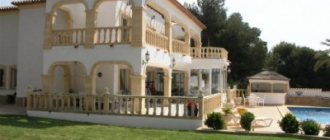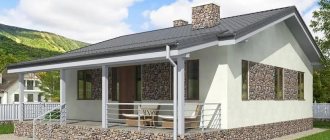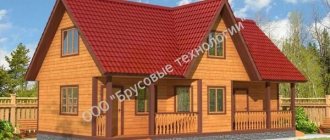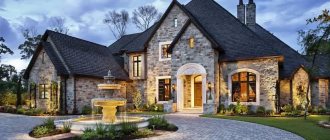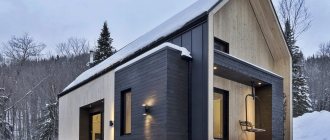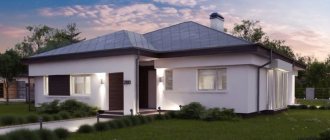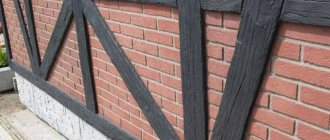History of the origin of the style
The origins of minimalism can confidently be considered avant-garde movements that emerged and rapidly gained strength in the 20-30s of the last century - constructivism and functionalism. New times required new ideas. Elaborate decorativeness and embellishment are a thing of the past; their place was taken by forms and techniques based on brevity and functionality.
The modern exterior and interior of minimalism finally took shape in the post-war era, in the 50-60s of the last century, when revolutionary-minded youth fought against the society of consumption and hoarding. The result was a trend that spanned all areas of art. Simplicity and laconism have taken root both in architecture and in interior design.
An example of modern minimalism in the design of a studio room Source chrome-effect.ru
Origins, history and architects
The features of minimalism in architecture first appeared in constructivism, an innovative architectural movement of the 20s of the last century. The formation of minimalism was greatly influenced by the Dutch artists who united around the magazine “Style” in 1917-1928. Unlike Soviet constructivism, which was based on engineering concepts, in the Netherlands the ideas of the mystical philosophical system of a local theosophist were used as a basis. The artists developed the basic principles of the style: asceticism of forms, purity of lines and colors. The ideas of the Dutch spread further and were picked up and developed by German and French architects:
- Walter Gropius. German architect. He designed residential, factory and commercial buildings in Germany, Belgium and Austria. Author of projects for Greek hotels, as well as the Baumfeld House in Berlin. In 1930 he took part in a competition for designs for a theater building for Kharkov and the Palace of Soviets for Moscow.
Department store designed by Gropius Source fy.wikipedia.org
- Bruno Taut. The architect, originally from Germany, became famous thanks to the residential complex he designed in the suburbs of Berlin - the village of Hufeisen. The residential areas of Berlin, in the creation of which Taut took part, were later included in the UNESCO World Heritage List.
- Erich Mendelsohn. German architect of Polish origin, author of numerous industrial buildings. Famous ones include the Einstein Tower (observatory in Potsdam), the Mosse House in Berlin, and the Luckenwald hat factory. He also designed the building of the power station of the Krasnoe Znamya textile factory in St. Petersburg.
- Le Corbusier. French architect, one of the initiators of the international style, a type of minimalism. Author of the concept of a “residential block” - an apartment building with shops, a post office, and a cafe located inside. One of the famous completed projects is the Marseille block, completed in 1952. Author of the National Museum of Western Art in Tokyo.
- Ludwig Mies van der Rohe. A modernist architect who worked in Germany and Russia, and before the war migrated to the United States. Known for his projects of private houses and Chicago skyscrapers. A famous work (and the prototype of numerous office buildings) was the Seagram Building in New York.
Private villa Tugendhat in Brno Source irop.mmr.cz
Signs of style in architecture and interior
Unlike other trends, the emphasis here is shifted from aesthetics to functionality. Minimalist architecture and exterior are described by the following characteristics:
- The design is based on a combination of vertical and horizontal lines ; There are practically no diagonal and curved silhouettes. The classic roof in the minimalist style is flat, allowing you to create an observation deck or a terrace for relaxation.
- Materials used are both natural (wood and stone) and artificial , including those that successfully imitate natural texture. It is not forbidden to combine expensive and budget materials - it is not the cost that comes to the fore, but the functionality and suitability for this particular project.
Strict geometry is a basic characteristic of the style Source rumahmu.web.id
- Houses in the minimalist style look natural in any landscape, since the design uses a natural color palette . The priority colors are white and black, as well as all sorts of shades of gray and brown. The strict range can be diluted with beige, green, and purple colors; No flashy, “acid” shades are allowed. Usually two contrasting shades and two additional ones are taken as a basis, helping to place accents.
In the interior design of a country house, the rules of the exterior are used; There are also a number of additional postulates:
- The basis of style is freedom . It is expressed in the openness and spaciousness of the premises, not cluttered with objects. The feeling of air is created through the use of multi-level lighting, glass and mirror surfaces.
- Laconic and discreet, graphic color scheme . Monochrome (gray or white) walls are welcome. There are no abstract patterns, checkered patterns or floral patterns in the design.
A recognizable feature of minimalism is the graphic nature of the palette Source koon.ru
- Finishing materials are simple, natural , often with a rough, untreated surface. Concrete, glass, brick, metal, wood are welcome; You can often find plaster.
Basic principles
The name of the style describes a certain way of life, which implies a rejection of the excesses of modern civilization. External simplicity with a minimum of details and an extremely limited range of colors does not make the style boring, but it helps to put thoughts in order.
One of the main features of the minimalist style in architecture is its versatility. Buildings with the most simplified forms can be found anywhere in the world; and it will not only be shopping centers, skyscrapers and factory floors. Increasingly, private houses are appearing whose owners liked the abandonment of the classical form.
There are several modern architectural concepts of the minimalist direction, among which the European and Japanese schools stand out for their interesting solutions. Despite some differences, it is easy to identify the basic principles:
- Maximum simplification of form. Minimalism in the exterior consists of horizontal and vertical planes. Since a simple form is chosen for each part of the building, the style consists exclusively of clear lines and flat surfaces.
Project with panoramic glazing Source www.spectechsolutions.com
- Neglect of decor. In strict outlines it is useless to look for smooth lines. When designing a house, the architect refuses any decorative elements in favor of ideal proportions of shape and color.
- Functionality. One of the sources of minimalism once became functionalism with its strict correspondence between form and purpose. Therefore, multiple functions are also encouraged here. If there is a roof, then with an observation deck; if the floor, then with heating (and you can do without a radiator).
- Additional techniques. In a logical space, light becomes of great importance. A variety of lamps are successfully used both in the interior and for façade illumination.
Interesting choice of shape Source pinterest.com
See also: Catalog of companies that specialize in designing country houses
Cottage projects in minimalist style
A modern minimalist house can be easily distinguished from other buildings thanks to the combination of simple volumetric solutions in the design - cubes and parallelepipeds, as well as trapezoidal and spherical sections. In the implemented projects there are other signs of architectural minimalism, among which are:
- Monolithicity . The house creates a strong feeling of a single whole, even if it consists of several (usually two or three) blocks. The feeling is not spoiled by the presence of an open terrace, often encircling the building, and various levels and niches. The design is also characterized by asymmetry.
A typical project in the style of a minimalist house Source koon.ru
- Number of storeys . The most common are one-story projects, as they are the most economical. Such houses retain functionality and the impression of spaciousness; at the same time, they minimize costs for design and engineering communications. Two- and three-story projects are distinguished by non-standard architectural solutions (from the second floor you can access a large terrace, a winter garden or a swimming pool).
- Selection of materials . House designs in the minimalist style often use foam and aerated concrete blocks. They significantly increase the speed of construction and at the same time give the structure the necessary rigor and rigidity specified by the project. Often the material for construction is brick and frame structures (with a steel base). Concrete is also in demand - many buildings are built using a monolithic method.
Range of materials
The geometricism and solidity of the building are emphasized by concrete, aerated concrete, foam concrete blocks, frames made of metal and chromed steel, lamellas and slats or corrugated sheets.
To a lesser extent, but with full right, brick and stone, ceramic, porcelain tiles, and composite panels are used.
Video description
About the features of minimalism in the following video:
- Significant glass area . This technique helps to visually expand the living space and fill it with sunlight. To create the effect of perspective and depth, not only panoramic windows (sometimes tinted), but also glass partitions are widely used. The shape of window openings is always rectangular; the style does not allow the use of figured details, arched structures and stained glass inserts.
- Smooth walls . Unlike extremely technological functionalism, minimalism focuses on creating a holistic look. Therefore, seam joints are carefully masked, the walls are leveled, and any convex decorative details are not allowed.
- Facade finishing . The background of façade walls is most often concrete. To finish it, plaster, natural and decorative stone, composite panels, planken (facade board), and clinker tiles are used.
The use of tempered glass in the decoration of a terrace fence for a house project in the minimalist style Source mkumodels.com
See also: Catalog of house projects in the minimalist style presented at the exhibition “Low-Rise Country”.
- Difference from high-tech . The styles are often confused due to the similarity of the exterior in many ways. Both directions use regular geometric shapes, restrained colors and a large glazing area. The difference lies in the use of materials. In the exterior of high-tech projects, the main ones are concrete, glass and steel. The design of minimalism is not so categorical and allows a combination of two or three facade finishing materials, due to which it looks more elegant.
Glazing degree
Panoramic windows are not mandatory, but a characteristic attribute of minimalism. Instead, there can be simply large-format windows without lintels, arches, grilles, cornices and with hidden fittings.
Windows are often cut into the roof; they make galleries, a transparent pediment. The cold shine of glass is softened by tinting: this improves the color scheme of the house and adds expressiveness to the exterior.
Types of minimalism in country architecture
Initially homogeneous, the style became cosmopolitan, and in different countries gradually began to acquire features of local color. Today there are several generally recognized areas:
- Soft-minimal . The minimalist space seemed cold and unsuitable for a comfortable life to many. This is how soft minimalism appeared, softening excessive sterility and gravitating towards eclecticism. The effect is achieved through the use of a warm color palette, natural textures and light accents. A country house looks more attractive thanks to cladding with plaster, wood and stone. The exterior is dominated by sand, cream and beige shades, diluted with deep brown and gray tones.
Home design in the style of soft minimalism Source topdom.info
- Eco-minimalism . In the construction and decoration of such houses, priority is given exclusively to natural materials, stone and wood. Acceptable additions are glass, plaster and ceramics. The roof in such projects finds a new use: a green lawn is arranged on it, flowers are planted, and there is often a place for solar panels. To ensure that the building fits well into the surrounding landscape, the walls are given various shades of green and brown.
- Scandinavian minimalism . Such projects use large quantities of natural wood, favored in Northern Europe. Panoramic glazing is widely used; Thanks to modern technologies, heat loss through large windows is reduced to a minimum. The interior space is often united according to the principle of a studio - in the north they try to use sunlight to the maximum.
Subspecies and categories
Japanese minimalism is a classic. It is characterized by clarity of proportions, elegance of lines, a contrasting color palette from white to black... As well as characteristic zoning techniques, niches-toconoms, sliding gratings and a “doll’s” garden near the house.
However, the ideology of minimalism is nourished not only by Japanese asceticism. Today there are:
Scandinavian minimalism.
Its features are natural wood as the base and cladding of the building, panoramic windows, neutral colors with a dominant white color.
Soft minimalism.
It is also called soft or new minimalism, since the software, while maintaining the principles and form, operates with a wide range of facing materials, paints and textures.
Eco-minimalism is a type that turns to natural raw materials and preaches unity with the environment.
Minimalism is also divided into:
- family-oriented, focused on comfort for people in the inner circle.
- Professional, which is created around the workplace.
- Practical - the most spacious and uncluttered with objects.
Video description
About the nuances of minimalism in the following video:
- Japanese minimalism . Creating a project requires the designer to have excellent taste and a sense of proportion in the use of contrasting black and white colors in the decoration of the facade. The graphically verified house has a rectangular volume. Zoning of premises is carried out using wooden, bamboo and glass partitions. Soft, diffused lighting of walls, wall niches and openings is often used. A characteristic feature of the Japanese style is different floor levels in different parts of the house.
Lightness and freshness of minimalist home exterior design
The best solution for minimalism is light, neutral tones. The monochromatic design gives the building a lightness. It looks light, fresh and cozy.
But dark shades are often used as the basis. In this case, they try to make the building futuristic and contrast it against the background of the natural landscape. Requires a lot of light.
In a minimalist home exterior design, there is no need to be afraid of simplicity of designs. Box-shaped, cubic shapes with openings without any additional decoration or design are perceived as a trend.
Interior design: basic principles
Unlike other ways to decorate a home, minimalism rarely allows for a mixture of styles. The interior of a country house in a minimalist style is based on the same simple and expressive techniques as the exterior. The following principles are taken as a basis:
- Freedom . The design of such housing cannot be imagined without empty spaces. However, the space is carefully thought out and organized, so the premises do not look abandoned. The style is characterized by open-plan spaces and high ceilings.
The main goal is free space Source orchidee.vn
- Invoice . Wood, artificial and natural stone, chromed steel, ceramics and glass are used in the interior design. To highlight, use brickwork, uneven plaster, metal with a decorative patina.
- Light . Thoughtful lighting plays an important role, as it participates in the zoning of rooms and helps to place accents. Light emphasizes architectural details and highlights individual objects (vases, paintings or sculptures). To create diffused light, central and point sources, halogen or neon lamps are used.
- Color . Classic minimalism is white, black and intermediate gray tones that create a graphic effect in the room. All shades of natural wood, ocher and clay, beige and khaki are also considered acceptable. A modern interpretation of the style allows the use of other bright colors as accents, for example, in wall decoration with colored plaster or tiles. A minimalist bathroom in basic colors creates a feeling of freshness and sophistication, even without additional accessories.
Features of the choice of color and material
The color scheme follows the form - it is also minimal. The color palette ideally contains two basic, rarely more, colors: white, black, shades of gray (but far from 50). The Japanese style direction suggests diluting the palette with soft tones characteristic of natural materials. Of course, for the human mind such a picture looks somewhat monotonous, so a bright accent is allowed, but only one (we are talking about minimalism). It could be a picture on the wall, a lamp or a chair.
The pedigree of minimalism involves the use in construction of not only natural, but also durable modern materials. Technologists make it possible to use recycled materials, for example, to use white or black marble chips for floor cladding. Favorite materials include glass, stone, wood, and chrome steel is preferred among metals.
Interior details
Simple, clear forms of decor in the style of minimalism give a feeling of calm and stability. The design of the basic elements of the rooms has the following characteristic features:
- Ceiling . It should be tall, light and plain; gray, sand and beige shades are preferred. If the area of the room allows, stretch multi-level ceilings are installed, which can have an additional zoning function. Ceilings, complex in shape, are complemented by spot and hidden lighting.
Using diverse lighting in the living room interior Source bezkovrov.com
- Floor . For it, high-quality materials are chosen in natural shades, without patterns or designs; The coverage may be different in different rooms. To maintain the style, use porcelain tiles (preferably large format), carpet, linoleum, self-leveling flooring. Parquet boards are laid in a straight or deck manner.
- Walls . Walls should not attract attention; they are made monochrome and monolithic. However, allocation (zoning) using wooden panels, clinker or stone masonry is allowed. The walls or niches are lined with glass, tiles or polished cement.
- Decor . The use of flashy textiles is excluded; bright sofa cushions, vases and numerous photographs on the mantelpiece can hopelessly ruin the style decision. The windows remain open or are equipped with roller blinds, blinds or translucent fabric curtains.
Accessories are selected in the main range of style Source saatchiart.com
Among other ways to decorate a modern interior, the minimalist style is valued for its clear and clear approach. The design of each room of a country house has its own nuances:
- Living room . It often represents a single space with a kitchen and a dining room. To prevent the room from looking busy, use built-in furniture. The laconic facade of the built-in wardrobe, devoid of decor and handles, best meets the style requirements. Upholstered furniture (chairs and sofas) should have a simple rectangular or square shape, without frivolous bends or bent legs. A panoramic window and the view opening from it can become the main part of the living room interior.
Living room in minimalist style Source midea.es
The emergence of a direction
Minimalism as an architectural trend began to take shape at the beginning of the 20th century, when Dutch artists, united by the De Stijl society, began to promote the beauty of rational and functional art.
In their opinion, there should be no unnecessary details in paintings, music or sculpture - only clean lines and colors.
This approach became the basis for the development of architectural minimalism, which became extremely popular during the restoration of Europe after the Second World War.
Interior design in the style of Japanese minimalism
Japanese national traditions are of persistent interest to European designers. Eastern culture with its simple forms creates a feeling of security and therefore is so in demand in the modern technogenic world. To decorate the interior of a country house in the Japanese style, the following basic principles are used:
- They try to use only natural materials .
- Three (less often four) colors are chosen , making the interior look restrained, if not ascetic.
- Shoji partitions, characteristic of Japanese houses, are installed only in truly spacious rooms.
- They zone the space not only with the help of lighting, but also with the level and color of the floor.
Minimalism in Japanese Source sfscentar.com
- Choose furniture with strict geometric shapes , use a lot of built-in wardrobes with sliding doors.
- Accessories are laconic and few in number . This could be graphics in simple frames, unglazed ceramics, or lamps with rice paper lampshades.
Lighting scheme
Without lighting design, a minimalist cottage looks lifeless and uninteresting. Architectural light, developed for a specific project, will focus attention on the style of the house and connect it with the landscape. To achieve this, use multi-level lamps with warm, not too harsh light. In particular, contour and curtain lighting, profile LED systems and compact pendant lamps are suitable for minimalism.
The style puts forward the following conditions for all lamps:
- conciseness of the model;
- simplicity of the material;
- naturalness of light, creating a calm, calm aura.
We must also not forget about basic safety. Outdoor devices should sufficiently illuminate the path leading to the house, lawn or lawn (a couple of LED balls or polyhedrons are enough), terrace, swimming pool, and other important objects. Fortunately, there are more than enough lamps on the market that correspond to minimalism.
Dynamic Exterior Minimalist Home Design
The following house options are more functional family cottages in a minimalist style made from natural materials. The peculiarity of the buildings is the practicality of the exterior.
The home's minimalist exterior design is designed to be multi-tasking with its unique aesthetic. There are outdoor seating areas that flow smoothly into open indoor living space. The façade is designed to provide an optimal balance of privacy and openness to the home.
Stylish exterior minimalist design of a house made from natural materials is restraint of form, harmony with nature and functionality. The building is characterized by comfort and corresponds to the trends of suburban housing construction, but at the same time it concentrates the best qualities of traditional real estate made of stone and wood.
